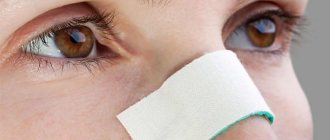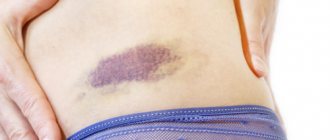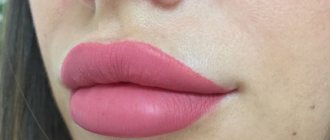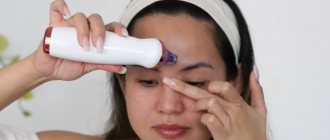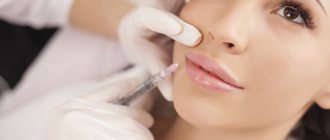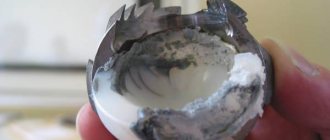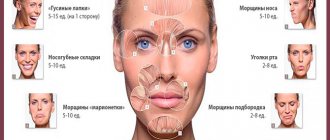How long does it take for a black eye to last - how long does it take for it to disappear?
In most cases, bruises appear after blows, injuries, or bruises.
Rarely have a pathological etiology or are a cosmetic defect. Special creams and ointments will help eliminate bruises.
Healing depends on the extent of the damage. If such manifestations are a consequence of an unhealthy lifestyle, then symptomatic treatment will not be effective.
Causes of a bruise under the eye
It is important to consider that a black eye under the eye, which is not associated with pathological processes, may appear for the following reasons:
- abuse of drugs, alcohol, smoking;
- intoxication of the body;
- chronic fatigue and poor sleep;
- incorrect makeup;
- use of low-quality skin care products;
- genetic predisposition;
- violation of the structure of blood vessels;
- the location of the vessels is too close to the surface of the skin.
In some people, a hematoma may occur with a mild bruise. The healing process takes a long time. This is affected by the specific type of skin. Many diseases can be accompanied by such signs.
In this case, bruises appear under both eyes. This is mainly due to disruption of the digestive system. This is often a sign of helminthiasis.
Worms cause intoxication and have many characteristic symptoms.
Symptoms
The first symptom of damage is pain. It all depends on the location of the injury. Unpleasant sensations can radiate to the head, face, nose. Often accompanied by headaches, discomfort, and burning. Heavy impacts can cause a concussion. In this case, the following symptoms occur: nausea, dizziness.
Rarely, partial or complete memory loss may occur.
It is worth considering that a blow to the bridge of the nose is always accompanied by bleeding. The injured person should know that blowing blood is prohibited. This can cause a lot of swelling.
Doctors recommend using cotton or gauze swabs in such cases. They are placed in each nostril. It is important to understand that cotton fibers can remain on the mucous membrane and cause the formation of pus.
Therefore, it is better to make tampons from bandage or gauze.
After the pain syndrome, redness appears. Change in skin color is a characteristic feature. It occurs within several hours after a blow or injury. After this, the color of the damaged skin gradually changes. Within 24 hours, the lesion can spread over a large area.
Heavy impacts lead to decreased visual acuity. Swelling causes difficulty closing the eyelids. It may be difficult for the affected person to close his eyes. This often causes pain.
How long does it take for a black eye to appear after a blow?
After a blow, the injured person initially experiences severe pain. Then swelling appears. It is important to consider that the extent of the damage initially causes only redness. Over the course of a day, the damaged area of skin begins to darken. The area of damage may double in size. This occurs due to internal bleeding.
In addition, additional symptoms may be observed: decreased visual acuity, headaches of various types. Swelling prevents you from fully opening or closing your eyes. Severe injuries can cause bleeding from the ears. In this case, you will need to urgently consult a doctor.
First aid
It is important to consider that timely provision of assistance ensures a favorable result. After a blow or bruise, apply cold to the damaged area. For this, ice is suitable, which must be wrapped in a towel. You can also apply a cold compress. The cold should be kept for 15 minutes, but no more. In this case, you need to pause periodically to avoid hypothermia.
Folk remedies must be used with extreme caution. Bee venom is popular. But it is forbidden to take it to eliminate bruises. The following medications are often used: Heparin ointment, “Bruise off”. These are products that are applied to the damaged eyelid or skin around the eyes.
The drugs promote rapid resorption of bruises and hematomas. If used immediately after the blow, a small bruise may disappear within 4 days. On the first day, ointments are used frequently, and then the dosage is gradually reduced.
How many days does a black eye last after a blow?
The presence of a hematoma at the healing stage is accompanied by a change in color. These signs can help you understand when a blow or injury occurred.
The shade changes depending on the processes that occur in damaged tissues. The appearance and development of a bruise can be divided into several stages. They develop over several days.
Completely disappears within 7-10 days. It depends on the extent of the lesion and timely treatment.
If you do not use medications, healing will proceed as follows:
- Redness appears within an hour;
- After 6 hours the color may turn purple, blue;
- After a day, the outline becomes brown with a green tint;
- Over the course of five days, the bruise will be blue in color and gradually turn yellow;
- After 7 days, the damaged area is significantly reduced in size;
- After two weeks, a yellow spot remains at the site of the bruise.
The bruise fades depending on the degree of damage and size.
Stages of bruise by day (photos for each stage)
The impact causes damage to blood vessels. Bleeding occurs under the skin, so it changes color depending on the severity of the injury.
First stage. The blood thickens and coagulates after the blow received. It begins to darken due to the processes that occur in the affected area. The skin takes on a blue, purple tint. This can be noticed within 24 hours after the impact. In this photo you can clearly see what the bruise will look like on the first day.
Second stage. After a few days, leukocytes accumulate in the damaged area. They lead to the destruction of red blood cells in hemoglobin. The last component begins to produce a green pigment, so the bruise takes on this shade around the 5th day. You can see this change in the photo.
Third stage. After these processes, bilirubin begins to be produced in the affected area. This component has a characteristic yellow color. That's why the bruise takes on this color.
The hematoma gradually disappears every day. After 9-10 days, the skin becomes natural color, and not a trace remains of the bruise.
Preparations for rapid resorption of a black eye after a blow
It is important to consider that a bruise caused by a blow can only be cured with special ointments and gels. The following means are mainly used:
- Lyoton. The ointment helps normalize blood flow in the affected area and accelerates tissue restoration. Helps get rid of bruises of varying severity. Apply to the damaged area 2-3 times a day for a week.
- Lyoton forte. The ointment is mainly used for varicose veins. But it eliminates swelling well and produces a resolving effect, so in severe cases it is recommended for bruises under the eyes. Apply to the affected skin 2 times a day until the hematoma disappears.
- Bruise off. This is a popular remedy that is found in almost every home medicine cabinet. The main substance in this product is leech extract. This component has an anti-inflammatory effect and improves local blood flow. Helps accelerate the regeneration of damaged tissues. It is worth noting that the ointment should be applied immediately after a blow or injury. This will help get rid of the bruise faster. Can be applied to skin 5 times a day.
- Badyaga. This drug contains natural ingredients. To make the bruise disappear, apply the ointment 3 times a day. Has an antibacterial effect, normalizes local blood circulation.
- Heparin ointment. A well-known remedy that is recommended to be taken for bruises of varying severity. After the impact, the ointment is applied every hour during the day. When it passes, use is reduced to every 2-3 hours.
Medicines do not require a doctor's prescription. They can be used independently at home. You should consult a doctor if there is bleeding, a cut, or when the blow was severe and led to a head injury. In this case, treatment will depend on the severity of the damage.
If the bruise lasts more than two weeks, you should also consult a specialist.
How to disguise a bruise
There is technology to disguise a bruise after a blow or cosmetic defect. If a person must be in a public place, at a holiday or just an important meeting, then his appearance must be impeccable. The bruise takes a long time to disappear, so the only option is to disguise it with special makeup. It can be done not only for women, but also for men.
It is problematic to eliminate visual damage to the bridge of the nose. It is difficult to mask consequences not related to physical factors. Some diseases provoke the appearance of bags and dark circles under the eyes. This affects the functionality of the entire body.
Such defects can be eliminated only with the right combination of eye shadow and concealer. But this will help temporarily improve your appearance. You can get rid of such defects only after treating the disease that causes such symptoms.
Was the article helpful?
Rate the material on a five-point scale!
( 4 4.50
Source: https://proglazki.ru/travmy/skolko-prohodit-sinyak-pod-glazom/
How to speed up the healing process
A popular method is to apply an ice pack. This will only work if done immediately after the hit. Cold constricts blood vessels, reducing hemorrhage, swelling and inflammation of the injury site. You can apply a cold compress through a layer of soft cloth, a towel, or simply over your clothes to prevent local frostbite.
Ointments and creams containing arnica montana extract, quercetin, vitamins B-3 and K contribute to the speedy healing of bruises. Before using painkillers, you should consult a doctor, since in some cases the drugs can only increase bleeding. For example, you should not take aspirin for hematomas; it thins the blood and increases hemorrhage.
Yellow bruises: what are they, why do they appear and how to deal with them
Every person has been in a situation where he accidentally fell and hit himself.
In almost all cases, a blue spot appeared on the part of the body where the main blow occurred, which, as it healed, lightened and changed its color to yellow.
Most people wait for this characteristic stain to disappear on its own. But what to do if a yellow bruise appears in the most visible place that cannot be hidden under clothes?
Ocher hematomas
Characteristic yellow bruises appear at the site of a bruise, inside which blood vessels have ruptured and released their contents under a layer of skin.
When the blood is outside the usual walls, the process of hemoglobin breakdown begins, which is responsible for the coloring of the bruised area.
At first it is purple, with a slight blue tint, then turns into a yellow-green color and gradually, approaching the moment of healing, becomes yellow-brown.
Among the most popular reasons for the appearance of bruises are the following:
- Lack of vitamin C.
- The memory accidentally erased the episode when the person fell or hit himself, considering it not so important.
- Pathologies in the functioning of endocrine organs or in their interaction with the central nervous system are fraught with the appearance of sudden bruises.
- Hypertension, tonsillitis, rheumatism and kidney disease, as well as pathologies in the circulatory system make themselves felt by colored spots throughout the body.
Bruises after injections
Reasons for appearance:
- Error in the process of choosing the injection site. For example, you need to give an injection on the upper part of your right buttock. Experienced doctors advise mentally dividing the buttock into four areas and injecting where necessary at the moment. If the person using the syringe made a mistake and hit another muscle part, sending the medicine to less elastic tissues, then there is a high probability that a bruise will appear in this place.
- The injection was not deep enough to have full impact. All gluteal muscles are located under an impressive layer of subcutaneous fat. If the syringe is not inserted to the full length of the needle, then the medicine is 100% likely to get into the fatty area, causing the formation of bruises.
- Got a viral infection. If foreign bacteria enter the body along with the injection, they will provoke the onset of a subcutaneous inflammatory process. In turn, it forms spots on the body that resemble multi-colored hematomas.
- They injected a very tense muscle. Under this influence, an abundant blood supply begins at the injection site, which can enter the fatty tissue. And blood that gets into the wrong place provokes the appearance of bruises.
When there is no special reason
It happens that characteristic hematomas appear on the body, but a person cannot remember the reason responsible for their formation. In this case, a special method will help, starting from the place where they appeared:
- Face and eyelids - more common in women whose bodies have entered the menopause phase. As a result of a lack of estrogen, a hormonal imbalance begins, tearing blood vessels and causing sudden bruising.
- Legs - due to vitamin deficiency, the vessels in this part of the body are too fragile.
- Abdomen - it is urgent to check the internal organs for hidden pathologies.
- Veins are a striking feature of varicose veins.
- Breasts - in some cases, they signal the onset of cancer.
Methods to quickly get rid of bruises
Fast-acting remedies for yellowish spots include medical ointments: “Gepatrombin gel”, “Fastum gel”, “Troxevasin”, “Indovazin” and so on.
If hematomas appear without the influence of a bruise, you can use more useful methods. You should include more egg yolks, fish oil and green foods like broccoli or spinach in your daily diet.
They contain a lot of potassium, without which normal blood clotting is impossible. For additional effect, you can make regular compresses at the site of the hematoma, consisting of boiled potatoes in their jackets, honey and soda.
This mixture is mixed until the consistency of a homogeneous paste and periodically lubricated bruises.
Onion lovers can use a different recipe.
You need to peel and boil one onion, make a paste out of it, add dried plantain leaves, ground into powder, honey and mix until it becomes a thick mass without lumps.
Before use, this paste is heated in a water bath and rubbed onto bruises three times a day, moving with a kind of compress for at least two hours.
Tincture of calendula flowers helps no less well. You can buy it at the pharmacy or prepare it yourself. For this purpose, 20 grams of herb are poured with 100 ml of alcohol infusion and infused in a dark place for 14 days. The finished tincture is filtered and compresses and lotions are prepared from it for sore spots.
If a person wants to reduce yellow bruises, then he can use aloe leaves or a mixture consisting of soy flour, which is attached to the surface of the bruise. In some cases, they can be replaced with garlic: pour 2 heads with vinegar for a day. If you rub the hematomas with this infusion at least a couple of times a day, you can achieve impressive results.
Help with medicines
Bruises often appear closer to the eyes, puzzling the fair half of humanity. They go to doctors for help, who provide them with a wide selection of modern drugs. The leading places are occupied by:
- "Troxevasin". Hematomas disappear without a trace within the first couple of days. But despite this effectiveness, this medicine requires increased attention. Sore areas must be treated every 60 minutes. The medication breaks down yellow bruises, promoting rapid healing and strengthening blood vessels. In the absence of contraindications, it is recommended for the prevention of such formations.
- "Bruise-off." Contains leech extracts that can cure hematomas of varying severity, alleviating pain and swelling. A pleasant bonus will be the masking abilities of the ointment, hiding minor imperfections of the skin. But you will have to use this ointment especially often: doctors advise rubbing bruises at least five times a day.
- "Lyoton." Strengthens blood vessels, keeping all inflammatory processes in check.
- Heparion ointment. Improves blood clotting, helping to forget about swelling and inflammatory processes. Using it three times a day will provide excellent pain relief to any vulnerable spot.
What does traditional medicine say?
If you turn to traditional medicine, you can find out many recipes with which yellow bruises will disappear in a matter of days. The most popular of them:
- Badyaga - dried seaweed, ground into powder. They are sold in every pharmacy. With their help, they make excellent lotions - the powder is diluted with water at room temperature in a 1:1 ratio, and especially bothersome bruises are rubbed with it. If you rub them 2 times a day, the yellowness, if not completely disappears, will decrease significantly.
- Potatoes are an excellent remedy in the fight against runny nose and viral infections. It can also help heal bruises. To do this, rub fresh potatoes and apply them to the hematoma. After the procedure is completed, the area is rinsed with water at room temperature.
- Herbal decoctions - coltsfoot, cornflower, chamomile, wild rosemary, linden blossom and celandine. After boiling water, add a teaspoon of herb and cook it for at least 10 minutes. Then you can turn off the fire and let the broth cool slightly. The finished tincture is filtered and used as needed. The most popular methods are to soak cotton pads with the tincture and apply them to the sore spots. Within a couple of days, the hematomas will completely disappear.
Now you know what yellow bruises are and how to get rid of them.
Source: https://labuda.blog/250990
The bruise has increased in size
A bruise is a hemorrhage into the subcutaneous fat from damaged small vessels. Under the skin, initially at the site of swelling from the bruise, a slightly painful, limited purple spot appears.
By the third day, it begins to blur, the swelling of the tissue decreases, and the blood poured into the subcutaneous tissue begins to be distributed throughout the intercellular spaces of the fat cells. The bruise begins to “bloom” with blue-greenish-yellow colors.
Due to changes in the structure of hemoglobin.
The question of growing subcutaneous hematomas is another topic.
Sometimes even a seemingly small injury can cause a bruise or hematoma. Of course, this invariably causes a feeling of frustration. Especially in the warm season, when there is no desire to wear long sleeves or hide your legs. How quickly does a bruise go away? Is it possible to speed up the process of its resorption? The answers to these questions are presented in the article.
It turns out that periods of change in the hematoma and the associated periods of restoration of the skin really exist. Let's consider the stages of soft tissue hematoma.
Definition of hematoma
Hematoma is an accumulation of blood inside the human body, which is post-traumatic in nature and appears due to rupture of blood vessels.
The formation of a bruise sometimes lasts for several hours and is accompanied by painful sensations. A hematoma can be either minor or putting pressure on soft tissues and nearby organs.
The result of a bruise manifests itself in the thickness of the muscles, under the skin or mucous membranes, in the brain, etc.
There are different stages of subcutaneous soft tissue hematoma.
If the vessels are characterized by increased fragility or insufficient blood clotting, bruises may appear after minor blows or even spontaneously.
Small hematomas most often go away on their own, but larger ones can occur, simultaneously forming connective tissue and complicating the functions of neighboring organs, and in some cases even suppuration appears.
The most dangerous hematomas are intracranial, as they compress the brain and can be fatal. They are mostly treated surgically; conservative therapy is used less frequently.
We will consider the stages of soft tissue hematoma later.
Causes
As already mentioned, most often hematomas occur as a result of post-traumatic bleeding occurring inside the body due to a blow, numerous bruises, strong compression and pinching of the skin.
But there is such a phenomenon as subarachnoid hemorrhage - the occurrence of deformation of soft tissues not only as a result of a severe bruise, but also as a consequence of various kinds of diseases of the internal organs.
Possible complications
The risk of infection and hematoma suppuration increases significantly if the body's defenses are reduced due to:
- exhaustion;
- age close to retirement;
- birth defects;
- immune system disorders.
Increased accumulation of blood in the organs responsible for the normal functioning of the body requires mandatory contact with a medical institution. The stages of soft tissue hematoma are of interest to many. We'll talk about this later.
Classification of hematomas
There are the following classifications of hematomas.
By the nature of placement: submucosal, subcutaneous, intermuscular, subfascial, localized in internal organs and in the cranial cavity.
In relation to the vessel: pulsating and non-pulsating hematomas.
According to the state of the blood within the injury: fresh (no clotting), clotted, hematomas, complicated by suppuration, infected.
According to clinical signs: encysted, limited and diffuse hematomas. The stages of each species are approximately the same.
Hematomas are also classified as follows:
- Arterial. It has a bright red tint and is filled with arterial blood.
- Venous. This is a hematoma, usually formed due to violations of the integrity of the veins, which acquire a purple hue and are characterized by inactivity and hardness. Most often, bruises are of a mixed nature, that is, they contain both arterial and venous blood.
- Subcutaneous hematoma. Appears under the upper skin, similar to a bruise. The cause of its occurrence is serious diseases (syphilis, tuberculosis, etc.).
- Intramuscular. Occurs due to the accumulation of blood in the muscles. Severe pain is felt in the area where the disease is localized, and the original functions of the muscle tissue are lost.
- Intracranial hematomas. They, in turn, are divided into epidural, subdural, intraventricular and intracerebral.
Source: https://www.parkinson-help.ru/venerologija/sinjak-uvelichilsja-v-razmerah/
Change in hematoma by day
Most of us are accustomed to the fact that a bruise is a skin defect that goes away on its own. However, hemorrhage in the upper layers of the skin can lead to dire consequences, so in some cases it is worth seeking medical help.
Why does a bruise appear?
In medicine, any bruise is considered a hematoma. It occurs against the background of rupture of blood capillaries and is formed for one of the reasons:
- The presence of diseases of internal organs, problems with the circulatory system (leukemia, hepatic cirrhosis, von Willebrand disease, varicose veins, vasculitis).
- Mechanical impact on the body (bruise, blow, compression, injections).
Bruises under the eyes, which are popularly called bags, occur due to overwork of the body. It can be caused by insomnia, stress, severe physical and mental stress, and excessive drinking.
The mechanism of bruise formation
The causes of hematomas are related to the anatomy of the skin. It consists of three layers:
- Epidermis. This is a thin area that does not have blood vessels and performs a protective function. With a closed injury, it is not damaged.
- Dermis. Consists of connective tissue fibers. The capillaries located in the dermis play a special role in the appearance of bruises. Pain at the site of the injury is felt due to the presence of nerve endings in this layer.
- Hypodermis. Subcutaneous fat is located deeper than the other layers. It contains small vessels. This is where bruises form, since adipose tissue is much softer than connective tissue.
The severity of damage cannot be assessed by the area of the hematoma. A huge bruise may not affect the lower layers of the skin and may not damage the muscles.
Other features of the body play a special role in the formation of hematomas:
- blood composition;
- permeability of vascular walls;
- thickness of adipose tissue;
- structure of blood vessels.
The older a person is, the more often he or she develops hematomas. A child may have no trace left after a blow, while an old person will have a huge bruise due to a similar injury. This is due to the weakening of blood vessels, loss of elasticity of the walls and impaired circulation in them.
Color change
The size and color of the bruise depend on several factors:
- location relative to the vessels (pulsating hematoma occurs as a result of disruption of a large artery, non-pulsating hematoma occurs due to damage to small capillaries);
- the amount of accumulated blood;
- duration of injury;
- force of mechanical action (the higher it is, the deeper the hemorrhage occurred in the tissue).
The appearance and resorption of a hematoma occurs in several stages, which are accompanied by a change in the shade of the bruise:
- Red-purple. The red color is a consequence of damage in the first hours after the injury. This shade is due to the penetration of red blood cells into the skin tissue, which contain oxyhemoglobin of the corresponding color. During these hours, a person feels the greatest pain, and edema forms in the form of swelling.
- Blue or purple. The next day, the bruise acquires this color because the process of oxidation of oxyhemoglobin in the tissues occurs. Resorption has not yet begun, but the swelling is gradually subsiding.
- Green. The hematoma acquires this shade 5-6 days after injury. This occurs due to the biochemical transformation of hemoglobin, which enters the tissue from red blood cells. Biliverdin is formed, which has a greenish tint. Pain and swelling will disappear by this time.
- Yellow. In the final stage, the bruise turns yellow because biliverdin is converted to bilirubin. Over time, the hematoma will disappear under the influence of macrophages, which absorb dead cells. The yellow spot dissolves and leaves no trace.
Similar phases are observed when a significant volume of blood is released. If ice was applied immediately after the blow, the bruise will not look as noticeable.
Home treatments
If the bruise is caused by a blow, you should apply something cold to the sore spot and hold it there throughout the day. This will help reduce the size of the hematoma and speed up its healing. After 2 days, warm compresses are applied. If, apart from the external manifestation of bruising and swelling, there are no other alarming signs, you can do without going to the doctor.
Today, the pharmaceutical market offers a huge number of products to get rid of bruises. These include:
- Lyoton;
- Troxevasin;
- Bruise-off;
- Heparin ointment;
- Badyaga;
- Voltaren;
- Finalgon;
- Hepatrombin.
These ointments have wound healing, regenerating and analgesic effects. It is advisable to use them 7-8 hours after the impact. If you apply them immediately, they will increase swelling and provoke the appearance of a more pronounced hematoma.
As non-traditional methods of treatment, lotions with aloe, compresses with tincture of calendula and golden mustache, cabbage or potatoes, and garlic infusion are suitable. Before using traditional recipes and medications, you should make sure there are no contraindications.
Red and pink
This is the first and shortest stage of a hematoma, when, at the first moment after the blow, oxygen-rich, brightly colored blood pours out under the skin. The area of damage and surrounding tissues swell and become painful to the touch.
- How to remove belly fat for a man
- 8 vacancies where retirees can work: how to find an employer
- SNILS for a child can now be issued without an application

